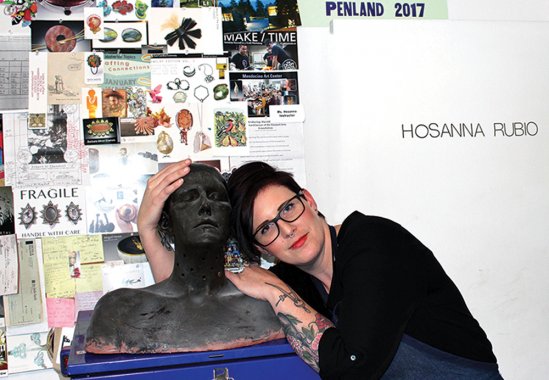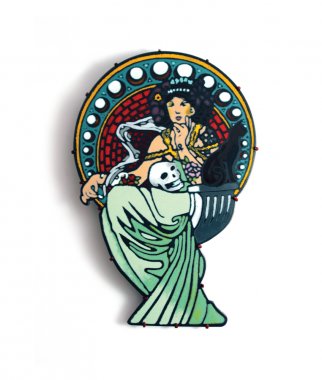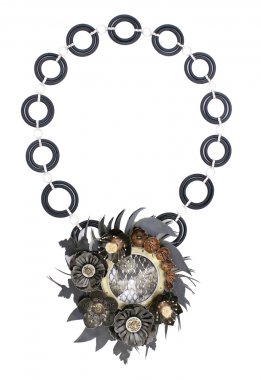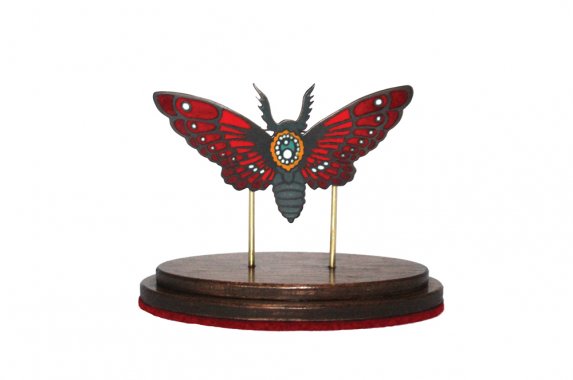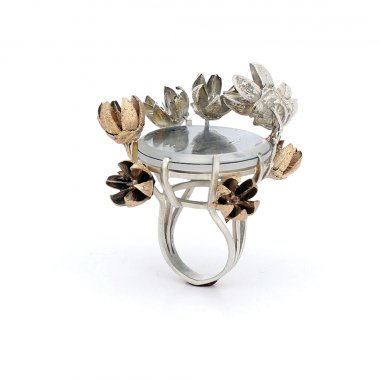Hosanna Rubio
Hosanna Rubio
“I’m pretty much an open book,” Hosanna Rubio admits with a laugh. She says this after a remarkably candid conversation that delved into her fundamentalist upbringing, the sexual assaults she survived as a child and a teen, her abusive early marriage, and the loss of her beloved grandmother to Alzheimer’s. At 32, Rubio has already overcome a series of hardships – and she churns those experiences into her jewelry, which is both honest and beautiful.
The Greenville, North Carolina, maker grew up in Southern California and earned a degree in art education at California State University, Long Beach, with an initial focus on painting and drawing. In her last semester, she signed up for an enameling course just because it sounded interesting. It was the last class she took – and the one that changed her trajectory as an artist. “Jewelry required the presence of the body to be fully appreciated,” she says. “That you had to take the body into account felt like the next natural step, because so much of my stuff had to do with illness and health and life and death,” she says.
Therapy and journaling have helped her heal, as has making jewelry, which Rubio says enables her to process difficult memories. Some of her work includes cunningly abstracted symbols that share intimate details from her life, such as X-rays of broken bones, sketches of domestic scenes, and images of medical bills. Other pieces present more universal motifs, including skulls and honeycomb. Her goal is to call attention to life’s transience and the possibilities for transformation that tragedy can present.
Rubio remains close to her family, though she has distanced herself from the conservative church she was raised in. Still, her religious upbringing has given her an appreciation for how little time we have on Earth. “We had this focus on life and death, of this idea of the seen and the unseen. And it can really have a strange effect on you, growing up,” she says. It’s no surprise, then, that her artwork is greatly influenced by vanitas paintings and memento mori jewelry, which use imagery such as bones, flowers, and insects to symbolize mortality. “I like to think of my work as a modern interpretation of those ideas. I want to celebrate the fleetingness of life, reclaim the beauty in the temporary, because it teaches you to fully appreciate every moment.” That’s a lesson she also holds dear because Alzheimer’s runs in her family.
Rubio honed her bench skills at East Carolina University, where she completed her MFA in metal design in 2017. An assistantship at the university’s 3D lab gave her the freedom to experiment with equipment such as the laser engraver, which “opened a world of possibility,” allowing her to cut hand-drawn patterns into delicate materials such as tulle and paper with precision, a trademark of her work. She went on to win the 2018 Lydon Emerging Artist Program Award from Contemporary Craft in Pittsburgh, which involves exhibiting her work at the organization’s retail gallery over the next year. She’s had requests from other galleries to feature her work but finds it hard to keep up with demand – her in-progress pieces tend to sell as soon as they’re posted on Instagram.
For Rubio, it’s an exciting position to be in, especially considering the tough journey it took to get there. “It kind of feels like I took all of that energy and frustration and pain and got to pour it into something that not only felt like a cathartic experience, but also allowed me to produce something I felt was beautiful,” she says. “Out of everything, this came.”
Heaven Is Other People
At first sight: “When I was really young, I remember sitting on the floor, staring up at my mother as she sketched this stone bust, just utterly trans- fixed by the way the graceful movements of her hand brought something new into the world – not just a replication but an impression of its presence. I think that’s the moment that I fell in love with art. It just felt like absolute magic.”
Making ends meet: Since earning her MFA, Rubio has been a Lyft driver, repaired jewelry, and worked as a studio assistant to several artists. Her favorite gig so far is teaching metals and jewelry at a nonprofit arts center near her home. “I get to interact with a variety of age groups, anywhere from 6 to 60, and share what I’m passionate about.”

